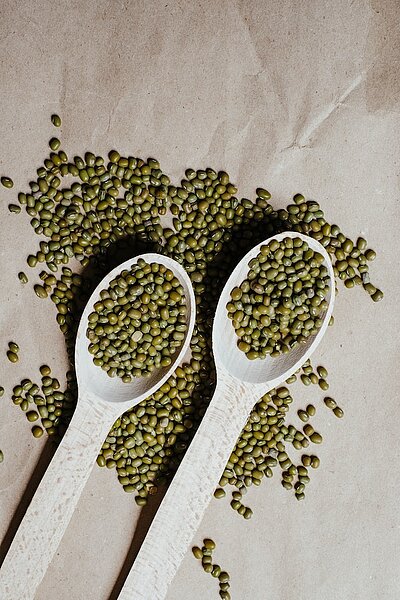Mung bean

What are mung beans?
Mung beans belong to the papilionaceous family and originally come from India. They have been cultivated for over 4000 years and are an important part of the diet in many countries. Mung beans have a round shape and a green skin that can be removed. The inside is yellowish and has a nutty flavor. Mung beans can be used as whole beans, as sprouts or as flour.
What are the benefits of mung beans for dogs?
Mung beans can be a good addition to a dog's diet as they contain many nutrients that are important for health. Mung beans provide, among other things:
- Protein: mung beans have a high protein content, which is important for muscle building and cell regeneration. Protein is also a source of amino acids, which are required for many metabolic processes.
- Fiber: Mung beans have a high fiber content, which aids digestion and regulates blood sugar levels. Fiber can also help increase satiety and control weight.
- Vitamins: Mung beans contain many vitamins, especially vitamins B1, B2, B3, B5, B6, B9 and C. These vitamins support the nervous system, the immune system, the skin and coat and blood formation.
- Minerals: Mung beans contain many minerals such as iron, calcium, magnesium, phosphorus, potassium, zinc and copper. These minerals are important for the bones, teeth, muscles, nerves and blood.
What are the disadvantages of mung beans for dogs?
Although mung beans are healthy, they are not suitable for every dog. There are some possible disadvantages or risks that you should be aware of:
- Bloat: Mung beans contain starches and sugars that are broken down by bacteria in the gut. This can produce gas, which can lead to bloating. This can be unpleasant for your dog and lead to digestive problems.
- Allergies: Mung beans can trigger allergic reactions in some dogs. This can manifest as skin rashes, itching, difficulty breathing or diarrhea. If you notice that your dog is allergic to mung beans, you should remove them from their diet immediately and consult a vet.
- Incompatibilities: Mung beans can cause intolerances in some dogs. This can manifest itself as abdominal pain, vomiting or diarrhea. If your dog is sensitive to mung beans, you should only feed them in small quantities or not at all.
- Overdosing: Mung beans should only be given as a supplement to food and should not be the main ingredient. Too many mung beans can lead to an overdose of nutrients, which can lead to health problems. For example, too much iron can lead to iron toxicity, which can be life-threatening.
How to feed mung beans to dogs?
If you want to feed your dog mung beans, you should follow some tips to maximize the benefits and minimize the disadvantages:
- Start with small amounts: To test whether your dog can tolerate mung beans, you should start with small amounts and observe the reaction. If your dog shows no symptoms, you can slowly increase the amount.
- Cook the mung beans: To improve digestibility and reduce bloating, you should cook the mung beans before feeding them. Cooking also destroys any harmful substances or germs that may be present in the beans.
- Mix the mung beans with other food: To ensure a balanced diet, you should mix the mung beans with other food, such as meat, vegetables or rice. This way you can also vary the taste and offer your dog variety.
- Observe the correct dosage: To avoid overdosing, you should stick to the correct dosage. The recommended amount of mung beans for dogs is around 10% of their daily food. This means that you can give your dog about 10 grams of mung beans per kilogram of body weight.
Mung beans can be a healthy and tasty addition to a dog's diet if they are prepared and dosed correctly. They provide many nutrients that are important for your dog's health. However, you should also be aware of possible disadvantages or risks.
Properties 1
Are you looking for other ingredients with a specific property?
Just click on them to find more.
If you notice any signs of hypersensitivity or poisoning in your dog, you should see your vet immediately. We are not a substitute for a vet, but we try to be as accurate as possible. Every dog reacts differently and we recommend you get a second opinion or consult your vet if in doubt.
Stay healthy and take good care of your four-legged friend!😊
Similar to Mung bean
Lentils are the seeds of plants from the papilionaceous family. There are different varieties of lentils, which differ in shape, color and taste. The best known are red, green and brown lentils....
The short answer is yes, but only cooked and in moderation. When raw, chickpeas contain the toxic substance phasin, which causes the red blood cells to clump together and can lead to diarrhea,...
Black beans contain many valuable nutrients that are important for your dog's health. These include: Fiber: It aids digestion and can prevent constipation or diarrhea.Protein: They provide...
Adzuki beans are small red beans that are mainly grown in China, Japan and Korea. They are also known as "red soybeans" and are related to mung beans. The beans have a sweet taste and are often used...



